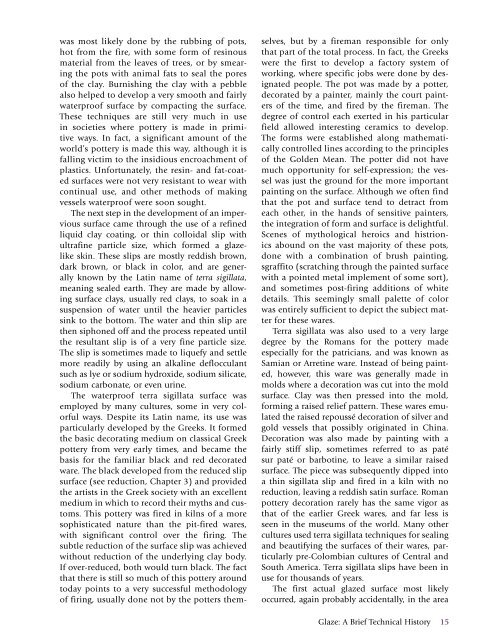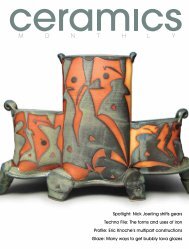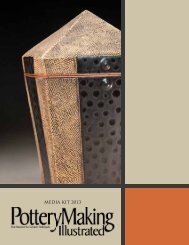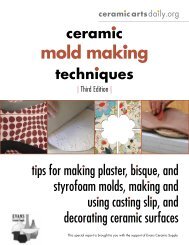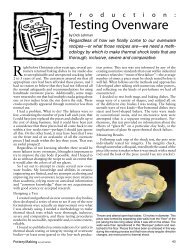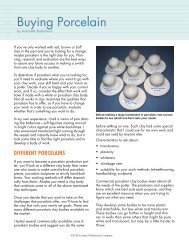Robin HoppeR - Ceramic Arts Daily
Robin HoppeR - Ceramic Arts Daily
Robin HoppeR - Ceramic Arts Daily
Create successful ePaper yourself
Turn your PDF publications into a flip-book with our unique Google optimized e-Paper software.
was most likely done by the rubbing of pots,<br />
hot from the fire, with some form of resinous<br />
material from the leaves of trees, or by smearing<br />
the pots with animal fats to seal the pores<br />
of the clay. Burnishing the clay with a pebble<br />
also helped to develop a very smooth and fairly<br />
waterproof surface by compacting the surface.<br />
These techniques are still very much in use<br />
in societies where pottery is made in primitive<br />
ways. In fact, a significant amount of the<br />
world’s pottery is made this way, although it is<br />
falling victim to the insidious encroachment of<br />
plastics. Unfortunately, the resin- and fat-coated<br />
surfaces were not very resistant to wear with<br />
continual use, and other methods of making<br />
vessels waterproof were soon sought.<br />
The next step in the development of an impervious<br />
surface came through the use of a refined<br />
liquid clay coating, or thin colloidal slip with<br />
ultrafine particle size, which formed a glazelike<br />
skin. These slips are mostly reddish brown,<br />
dark brown, or black in color, and are generally<br />
known by the Latin name of terra sigillata,<br />
meaning sealed earth. They are made by allowing<br />
surface clays, usually red clays, to soak in a<br />
suspension of water until the heavier particles<br />
sink to the bottom. The water and thin slip are<br />
then siphoned off and the process repeated until<br />
the resultant slip is of a very fine particle size.<br />
The slip is sometimes made to liquefy and settle<br />
more readily by using an alkaline deflocculant<br />
such as lye or sodium hydroxide, sodium silicate,<br />
sodium carbonate, or even urine.<br />
The waterproof terra sigillata surface was<br />
employed by many cultures, some in very colorful<br />
ways. Despite its Latin name, its use was<br />
particularly developed by the Greeks. It formed<br />
the basic decorating medium on classical Greek<br />
pottery from very early times, and became the<br />
basis for the familiar black and red decorated<br />
ware. The black developed from the reduced slip<br />
surface (see reduction, Chapter 3) and provided<br />
the artists in the Greek society with an excellent<br />
medium in which to record their myths and customs.<br />
This pottery was fired in kilns of a more<br />
sophisticated nature than the pit-fired wares,<br />
with significant control over the firing. The<br />
subtle reduction of the surface slip was achieved<br />
without reduction of the underlying clay body.<br />
If over-reduced, both would turn black. The fact<br />
that there is still so much of this pottery around<br />
today points to a very successful methodology<br />
of firing, usually done not by the potters them-<br />
selves, but by a fireman responsible for only<br />
that part of the total process. In fact, the Greeks<br />
were the first to develop a factory system of<br />
working, where specific jobs were done by designated<br />
people. The pot was made by a potter,<br />
decorated by a painter, mainly the court painters<br />
of the time, and fired by the fireman. The<br />
degree of control each exerted in his particular<br />
field allowed interesting ceramics to develop.<br />
The forms were established along mathematically<br />
controlled lines according to the principles<br />
of the Golden Mean. The potter did not have<br />
much opportunity for self-expression; the vessel<br />
was just the ground for the more important<br />
painting on the surface. Although we often find<br />
that the pot and surface tend to detract from<br />
each other, in the hands of sensitive painters,<br />
the integration of form and surface is delightful.<br />
Scenes of mythological heroics and histrionics<br />
abound on the vast majority of these pots,<br />
done with a combination of brush painting,<br />
sgraffito (scratching through the painted surface<br />
with a pointed metal implement of some sort),<br />
and sometimes post-firing additions of white<br />
details. This seemingly small palette of color<br />
was entirely sufficient to depict the subject matter<br />
for these wares.<br />
Terra sigillata was also used to a very large<br />
degree by the Romans for the pottery made<br />
especially for the patricians, and was known as<br />
Samian or Arretine ware. Instead of being painted,<br />
however, this ware was generally made in<br />
molds where a decoration was cut into the mold<br />
surface. Clay was then pressed into the mold,<br />
forming a raised relief pattern. These wares emulated<br />
the raised repoussé decoration of silver and<br />
gold vessels that possibly originated in China.<br />
Decoration was also made by painting with a<br />
fairly stiff slip, sometimes referred to as paté<br />
sur paté or barbotine, to leave a similar raised<br />
surface. The piece was subsequently dipped into<br />
a thin sigillata slip and fired in a kiln with no<br />
reduction, leaving a reddish satin surface. Roman<br />
pottery decoration rarely has the same vigor as<br />
that of the earlier Greek wares, and far less is<br />
seen in the museums of the world. Many other<br />
cultures used terra sigillata techniques for sealing<br />
and beautifying the surfaces of their wares, particularly<br />
pre-Colombian cultures of Central and<br />
South America. Terra sigillata slips have been in<br />
use for thousands of years.<br />
The first actual glazed surface most likely<br />
occurred, again probably accidentally, in the area<br />
Glaze: A Brief Technical History 15


